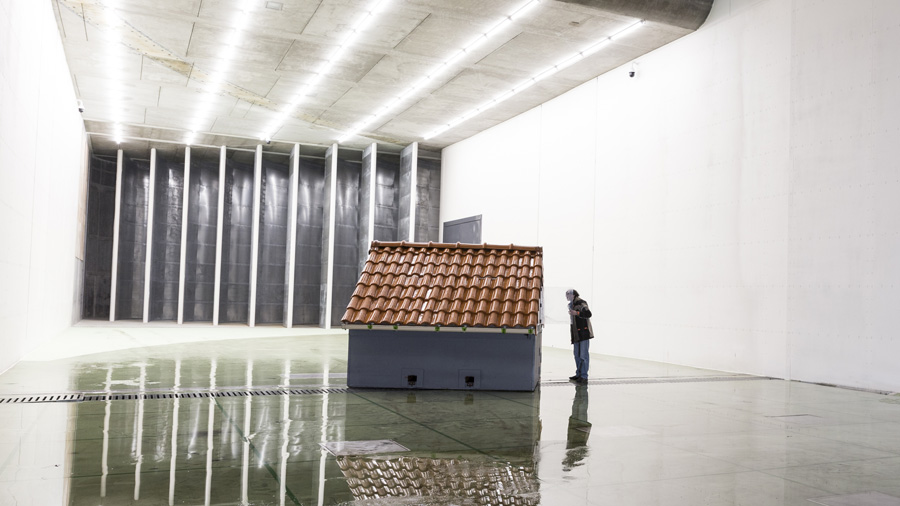The Jules Verne climatic wind tunnel at the CSTB site in Nantes is used for full-scale studies of building and construction components, as well as of vehicles and transport equipment. All types of climate conditions can be reproduced: snow, rain, sleet, fog, sandstorms, cyclones, heatwaves, etc.

A broad range of climatic parameters
The dynamic circuit includes four test sections. The space-time structure of wind, rain and sandstorms up to 90 km/h can be reproduced in the atmospheric test section. The aeroacoustic section serves to study noise coming from double-skinned external walls, roof appendages or other components capable of generating noise levels higher than a city's ambient background noise. The aerodynamic test section is equipped with a dynamometric scale which measures aerodynamic coefficients of up to 280 km/h. The airflow test section is dedicated to testing ventilation equipment, or it is used for destructive testing.
The thermal circuit reproduces a wide range of climates in combination with air flows up to 140 km/h. The ambient temperature and humidity are closely controlled. Various types of precipitation are reproduced, such as rain, fog and snow. The system being studied can also be subjected to intense radiant flux from the solar simulator.
The Jules Verne climatic wind tunnel offers a wide range of testing possibilities for areas as diverse as construction and civil engineering, national defense, shipyards, the automotive industry and aeronautics.
Diverse areas of activity and services
Product design and performance
- Effects of the wind on structures and components, on buildings, equipment, vehicles: loads, holding force, deformation, vibrations, dynamic behavior and stability, partial destruction, aeroacoustic noise, cyclone resistant design, etc.
- The effects of wind, combined with other climatic parameters: weathertightness of roofs, fogging and condensation, infiltration, etc.
- Study and performance of materials and equipment exposed to wind, water, air, temperature, snow, sun radiation, sand and dust, especially in harsh climate conditions
- Studying industrial aerodynamics requires full-scale experiments: road vehicles, ships, sailboats, rotating machines and wind turbines, sensors, special equipment
- Combined digital (CFD) and experimental approaches
Comfort-Environment
- Soiling
- Aeroacoustics
- Controlled aerodynamic and air flow fields
- Air flow, ventilation, air quality and thermal systems from the scale of the component to the scale of a neighborhood
- Sealed against water, air, effluents, dust
- Air-conditioning and air renewal
- Biophysics and climate environment
Vehicle safety
- Simulation of driving conditions in rain or snow
- Visibility in rain and fog conditions
- Stability in wind gusts
- Defogging
- Behavior of mechanical units in extreme climate conditions
- Behavior of braking systems
- Analysis of the comfort of the vehicle's interior
- Aerodynamic studies of trains (resistance to forward motion, side winds)

 Major Structures
Major Structures  Transportation
Transportation